#spanish conquest
Text
Stunning Codex Documenting Aztec Culture Now Fully Digitized
The 16th-century “Florentine Codex” offers a Mexican Indigenous perspective that is often missing from historical accounts of the period.
{read}
#tiktok#article#Florentine Codex#16th century#nahuatl#aztec#hyperallergic#colonialism#colonization#genocide#spain#digital archives#art#art history#language#spanish conquest#indigenous#mexico#history
262 notes
·
View notes
Text

For #WorldSerpentDay: Quetzalcoatl, the feathered serpent deity of the Aztecs, shown here in full zoomorphic form snacking on a human in the Codex Telleriano-Remensis, c. 1563. [BnF MS Mexicain 385 f. 18r]
#snake#serpent#snake deity#serpent deity#snake god#serpent god#feathered serpent#Quetzalcoatl#Aztec#Mexica#Mesoamerican art#Indigenous American art#codex#Mesoamerican codex#illuminated manuscript#illustration#painting#the feathered serpent deity of the Aztecs#Spanish conquest#Codex Telleriano-Remensis#16th century#World Serpent Day#zoomorphic#animals in art
83 notes
·
View notes
Text
Conquest of the two large mainland empires, those of the Aztecs and Incas, followed in 1519-1520 and 1532-1533, respectively.
"Guns, Germs and Steel: A Short History of Everybody for the Last 13,000 Years" - Jared Diamond
#book quote#guns germs and steel#jared diamond#nonfiction#spanish conquest#aztec empire#inca empire#colonization#10s#20s#30s#1510s#1520s#1530s#16th century
8 notes
·
View notes
Text
La Malinche: Mexico's Mestizo Origins
La Malinche: Mexico’s Mestizo Origins
For those who don’t know, La Malinche was the young woman-child and slave sold to Hernan Cortes on the Maya coast of Mexico in 1521. She was traded by the Chontal Maya along with 19 other 12-year olds. Her narrative is complex and formidable. An exhibit at the Albuquerque Museum examines her role as survivor, interpretor, and companion. In viewing the exhibit and knowing of her story, I continue…
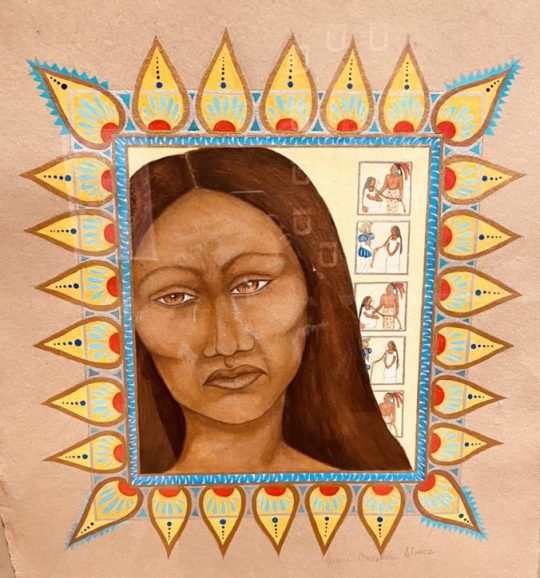
View On WordPress
#Albuquerque Museum#Dance of the Feather#Dance of the Matachines#Doña Marina#feminism#Hernan Cortes#La Malinche#Mexico#New Mexico#Oaxaca#Spanish conquest#violence against women
3 notes
·
View notes
Text
In 1502, Motecuzoma II rose as the Aztec ruler, merging priesthood with authoritarian rule. Faced with the Spanish conquest and wavering faith, he met a tragic end, marking the fall of the Aztec Empire's ascendancy from obscurity.
0 notes
Text
Exploring Mexico's Historic Cities: Spanish Colonial Foundations
Jose Mier Traces Ancestors’ Route from Spain to Sun Valley, CA
Jose Mier in Sun Valley, CA is surrounded by family and friends who share a similar heritage. Explorers from Spain moved westward to Mexico and their descendants move to what is now the United States. The U.S. is a young country by comparison to Mexico, some cities of which were founded in the 16th century.
Mexico, with its rich…
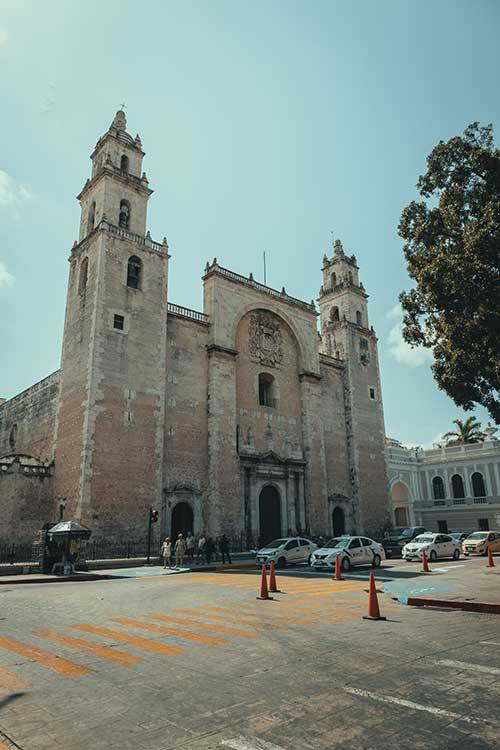
View On WordPress
1 note
·
View note
Text
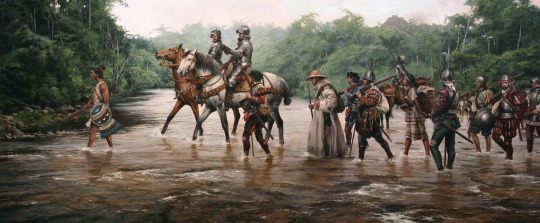
The March to Tenochtitlan by Augusto Ferrer-Dalmau
#hernán cortés#conquistador#art#augusto ferrer dalmau#conquistadors#tenochtitlan#tenochtitlán#mexico#spanish#spain#aztec#aztecs#mexica#mesoamerica#bartolomé de olmedo#pedro de alvarado#americas#history#european#age of discovery#age of exploration#explorer#spanish empire#conquest#aztec empire#expedition#river#friar#knight#priest
85 notes
·
View notes
Text
i need leftists to cope with their post 9/11 + Iraq/Afghan wars Islamophobia guilt in a way that doesn’t involve erasing the fact that, like it or not, Islam is a proselytizing religion that has fueled centuries of colonization, genocide, and imperialism. idealizing Islam as a purer, better alternative to Christianity is in itself Islamophobic, and it also ignores the many communities who have suffered at the hands of Islamic imperialism. it is possible to not be Islamophobic while acknowledging that.
#tonight on posts i might get cancelled for#i’m just so tired of people pretending that Islamization wasn’t destructive#and that Jews living under Muslim rule didn’t suffer#part of my family is Turkish#lived there during Ottoman rule#it wasn’t a good time!#and then there’s the Spanish Inquisition which. i simply cannot get started on rn#point is framing Islam as an uwu peace and love religion with no history of violence and conquest is wrong and orientalist!
40 notes
·
View notes
Text
History memes #49
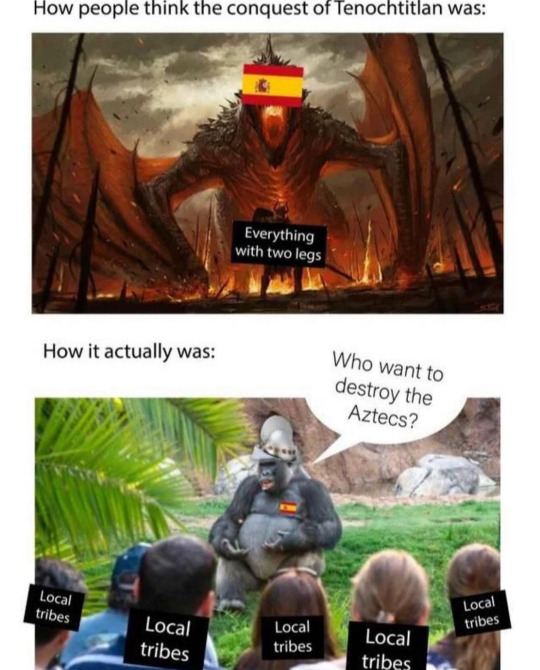
So, fun fact, most of the army that conquered the Aztecs were actually made up of other peoples in Mexico who decided they hated the Aztecs more than the newly arrived Spanish
#funny humor#history memes#funny memes#history#funny#humor#meme humor#dark humor#aztec#aztec empire#spanish empire#spanish#spain#mexico#mexican history#conquistador#Spanish conquest of Mexico#1500s#renaissance#renaissance history
34 notes
·
View notes
Note
St Patrick's Day celebrates the successful conversion of Ireland to Christianity. Religious conversions are inherently violent and hostile, it was cultural genocide.
hm lots of historical interventions being made here that i do not think i am going to unpack so i will just say that i do not think that is at all the meaning of the holiday as it is celebrated in the united states where has been watered down into “irish people? they’re cool. let’s party”
40 notes
·
View notes
Text

Juan Ventura de Miranda (Spanish, 1723-1805)
The conquest of Oran by Spanish troops, 1760
Real Academia de Bellas Artes de San Fernando
#Juan Ventura de Miranda#spanish#spanish art#art#1700s#fine art#european art#classical art#europe#european#oil painting#fine arts#europa#mediterranean#the conquest of oran by spanish troops#hispanic#latin#southern europe#western civilization
53 notes
·
View notes
Text

"Pizarro started from nothing, rising to a life of conquest and glory. He toppled the Inca with an act of Odyssean cunning. After years of war, he went out in a blaze of glory, fighting off assassins even in his old age… is this not Bronze Age Mindset?
Is this not greatness?".
-Alaric the Barbarian.
#Francisco de Pizarro#Pizarro#conquistadors#Spaniards#Spanish empire#Crown of Castile#Bronze Age Mindset#Alaric#Alaric the Barbarian#glory#indo-european#Europe#Tradition#Conquest#The Odyssey#Homer#castile#Exploration#Isabel of Castile#Catholic monarchs#Catholic Queen#cross of burgundy#myth#frontier#America
14 notes
·
View notes
Text
Second part of the bookscans of Al Andalus. Historical Figures, here's the previous part
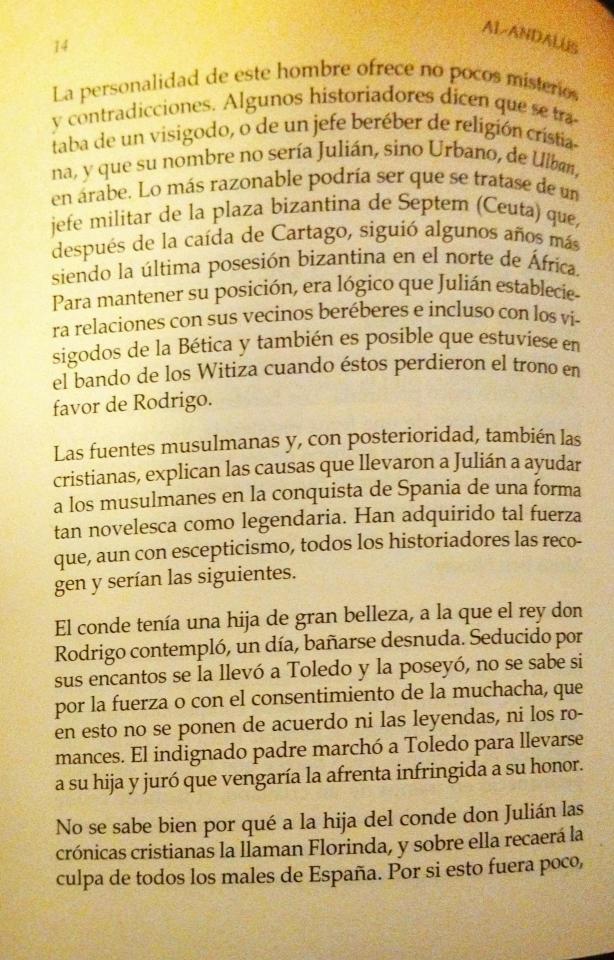
The personality of this man offers many mysteries and contradictions. Some historians say that he was a Visigoth, or a Berber of Christian religion, and that his name would not be Julián, but Urban, from Ulban, in Arabic. The most reasonable thing could be that he is a military commander from the Byzantine square of Septem (Ceuta) which, after the fall of Carthage, continued to be the last Byzantine position in North Africa for a few more years. To maintain his position, it was logical that Julián established relations with his Berber neighbors and even the Visigoths of Baetica and it is also possible that he was on the side of the Witizas when they lost the throne in favor of Rodrigo.
The Muslim sources and, later, also the
Christians, explain the causes that led Julián to help the Muslims in the conquest of Spania in such a way
novel as well as legendary. They have acquired such strength that, even
with skepticism, all historians collect them and they would be the following.
The count had a daughter of great beauty, whom the king Rodrigo, one day, contemplated her bathing naked. Seduced by her charms he took her to Toledo and possessed her, it is not known if because of force or with the consent of the girl, who in this neither legends nor romances agree. The indignant father marched to Toledo to take his daughter and swore
that he would avenge the affront inflicted on her honor.
It is not well known why the daughter of Count Don Julián is called Florinda in Christian chronicles, and on her will fall the
blame for all the ills of Spain. As if this were not enough,
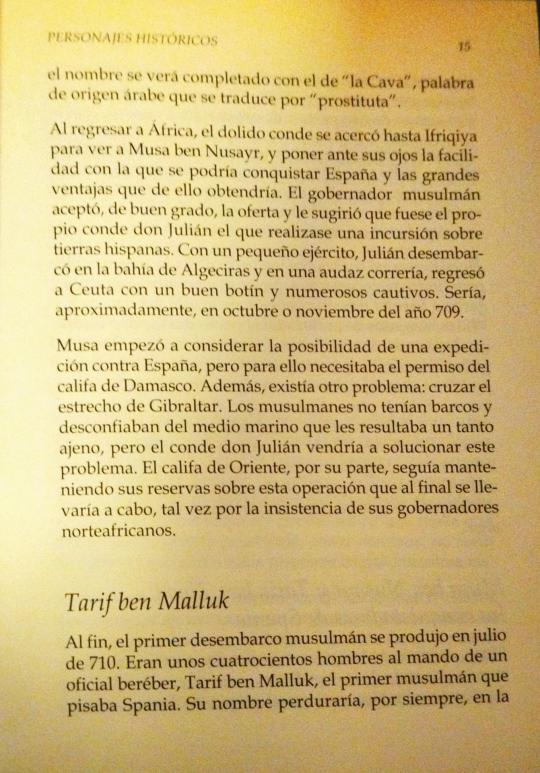
the name will be completed with “la Cava”, a word of Arabic origin which translates to "prostitute".
Upon returning to Africa, the hurt count went to Ifriqiya to see Musa ben Nusayr, and put before his eyes the ease with which one could conquer Spania and the great advantages that would be obtained from it. The Muslim governor willingly accepted the offer and suggested that it would be Count Don Julián himself who carried out an incursion onHispanic lands. With a small army, Julian landed in the bay of Algeciras and in a daring raid, he returned to Ceuta with good loot and numerous captives. It would be approximately October or November of the year 709.
Musa began to consider the possibility of an expedition against Spania, but for this he needed the permission of the Caliph of Damascus. In addition, there was another problem: crossing the Strait of Gibraltar. The Muslims did not have ships and distrusted the marine environment that they considered a bit strange, but Count Don Julián would come to solve this problem. The Caliph of the East, for his part, continued to maintain his reservations about this operation that would ultimately be carried out, perhaps because the insistence of their North African governors.
Tarif ben Malluk
Finally, the first Muslim landing occurred in July 710. There were about four hundred men under the command of a Berber officer, Tarif ben Malluk, the first Muslim to set foot in Spania. His name would last, forever, in the
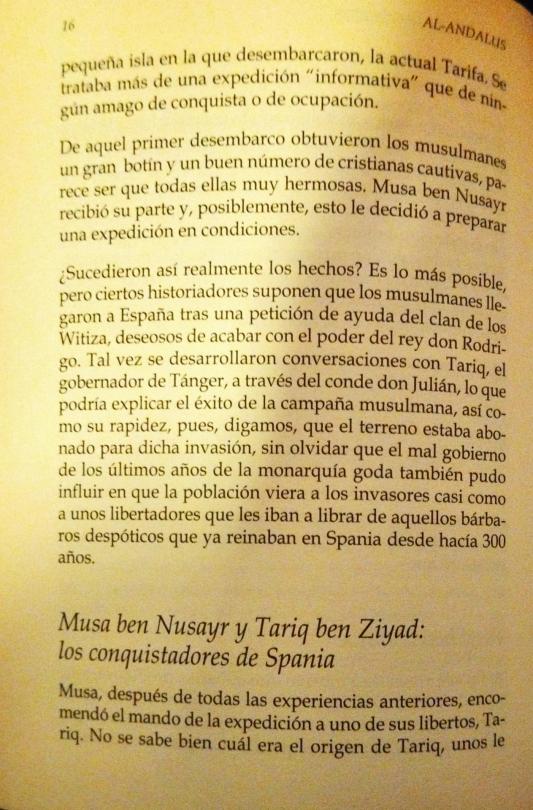
small island where they landed, the current Tarifa. It was more of an “informative” expedition than a threat of conquest or occupation.
From that first landing the Muslims obtained Muslims obtained a
great booty and a good number of captive Christian women, it seems to be
that all of them are very beautiful. Musa ben Nusayr received his part and, possibly, this decided him to prepare a proper expedition.
Did the events really happen like this? It is the most possible, butcertain historians suppose that the Muslims came to
Spania after a request for help from the Witiza clan, eager to put an end to the power of King Don Rodrigo. Maybe
conversations took place with Tariq, the governor of Tangier, through Count Don Julián, which could explain the
success of the Muslim campaign, as well as its speed, therefore, let's say that the ground was fertile for said invasion,
without forgetting that the bad government of the last years of the
Gothic monarchy could also influence the population to see the invaders almost as if they were liberators who were going to
rid of those despotic barbarians who already reigned in Spania for 300 years.
Musa ben Nusayr and Tariq ben Ziyad:
the conquerors of Spania
Musa, after all the previous experiences, entrusted the command of the expedition to one of his freedmen, Tariq.
It is not well known what Tariq's origin was, some
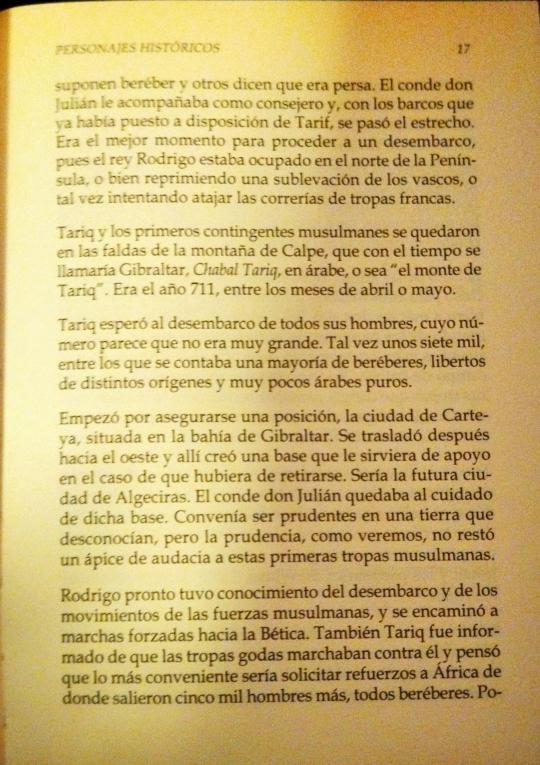
assume he was Berber and others say he was Persian. Count Don Julián
accompanied him as a counselor and, with the ships that he had already put to
Tarif's disposition, the strait was crossed. It was the best time to proceed to landing, since King Rodrigo was busy in the
north of the Peninsula, or repressing an uprising of the Basques, or perhaps trying to stop the raids of Frankish troops.
Tariq and the first Muslim contingents stayed in the foothills of the Calpe mountain, which in time would be called Gibraltar, Chabal Tariq, in Arabic, that is, “the mountain of Tariq.” It was the year 711,
between the months of April or May.
Tariq waited for all his men to disembark, whose number seems like it wasn't very big. Perhaps seven thousand, among whom the majority were Berbers, freedmen of different origins and
very few pure Arabs.
He began by securing a position, the city of Carteya, located in the bay of Gibraltar. He then moved west and there created
a base that would serve as support in the event that it had to backing out. It would be the future city of Algeciras. Count Don Julián was in the care of said base. It was advisable to be cautious in a
land that they did not know, but prudence, as we will see, did not took less audacity to these first Muslim troops.
Rodrigo soon learned of the landing and the movements of the Muslim forces, and set out on marches forced towards Baetica. Tariq was also informed that the
Gothic troops were marching against him and he thought that the most convenient
would be to request reinforcements from Africa where five thousand men came from
more, all Berbers. Po-
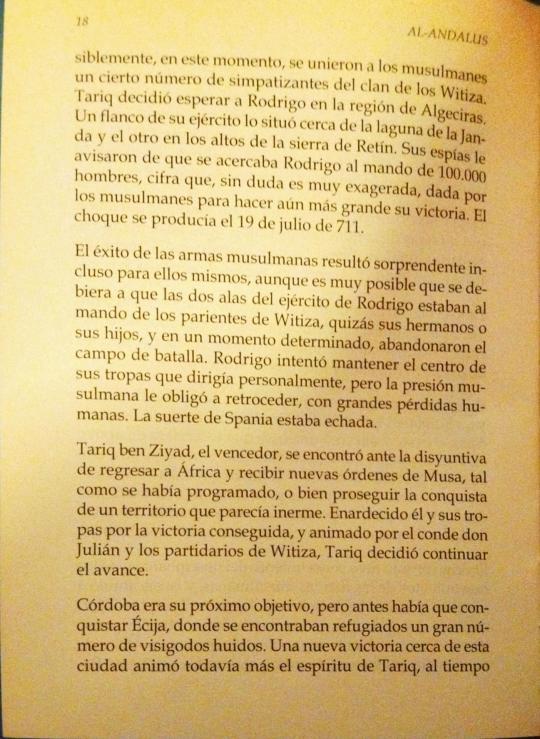
ssibly, at this time, the Muslims were joined by a certain number of sympathizers of the Witiza clan. Tariq decided
wait for Rodrigo in the region of Algeciras. One flank of his army was placed near the Janda lagoon and the other on the heights of the Retín mountain range. His spies warned him that Rodrigo was approaching
commanding 100,000 men, a figure that is undoubtedly very exaggerated, given by the Muslims to make even bigger their victory. The clash occurred on July 19, 711.
The success of Muslim weapons was surprising even for themselves, although it is very possible that it was because
the two wings of Rodrigo's army were commanded by the relatives of Witiza, perhaps his brothers or his children, and in a certain moment, they left the battlefield. Rodrigo tried to hold the center of his troops that he led personally, but Muslim pressure forced him to retreat,
with great human losses. Spania's luck was
cast.
Tariq ben Ziyad, the victor, found himself faced with the dilemma of returning to Africa and receiving new orders from Musa, as had been scheduled, or continuing the conquest of a territory that seemed defenseless. He and his troops were enraged by the victory achieved, and encouraged by Count Don Julián and Witiza's supporters, Tariq decided to continue the advance.
Córdoba was their next objective, but first they had to conquer Écija, where a large number of escaped Visigoths were taking refuge. A new victory near this city encouraged Tariq's spirit even more, while
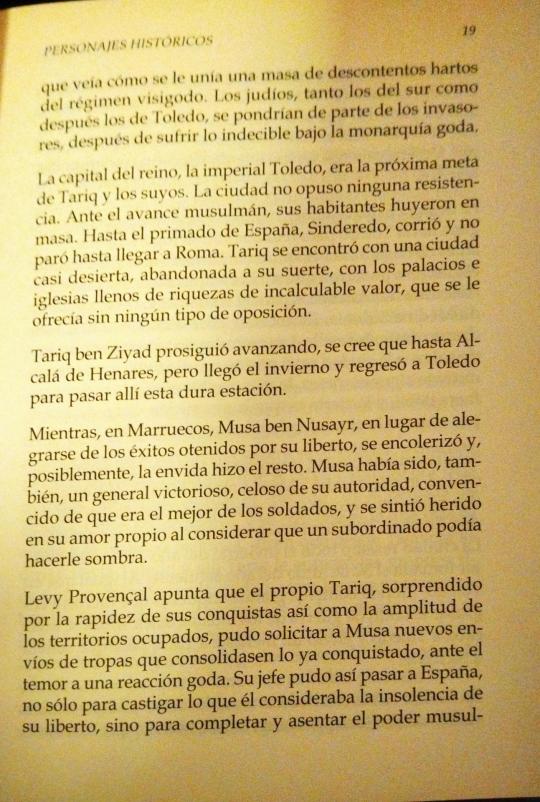
he saw how he was joined by a mass of dissatisfied people fed up with the Visigothic regime. The Jews, both those of the south and later those of Toledo, would side with the invaders, after suffering the unspeakable under the Gothic monarchy.
The capital of the kingdom, the imperial Toledo, was the next goal of Tariq and his people. The city did not put up any resistance. Faced with the Muslim advance, its inhabitants fled. Even the primate of Spania, Sinderedo, ran away and did not stop until he reached Rome. Tariq found an almost deserted city, abandoned to its fate, with palaces and churches full of riches of incalculable value, which were offered to him without any type of opposition.
Tariq ben Ziyad continued advancing, it is believed as far as Alcalá de Henares, but winter arrived and he returned to Toledo to spend this hard season there.
Meanwhile, in Morocco, Musa ben Nusayr, instead of rejoicing at the successes achieved by his freedman, became angry and, possibly, envy did the rest. Musa had also been a victorious general, jealous of his authority, convinced that he was the best of soldiers, and he felt hurt in his self-esteem when he considered that a subordinate could overshadow him.
Levy Provençal points out that Tariq himself, surprised by the speed of his conquests as well as the breadth of the occupied territories, was able to request new shipments of troops from Musa to consolidate what had already been conquered, fearing a Gothic reaction. His leader was thus able to go to Spania, not only to punish what he considered the insolence of his freedman, but to complete and establish Mus-
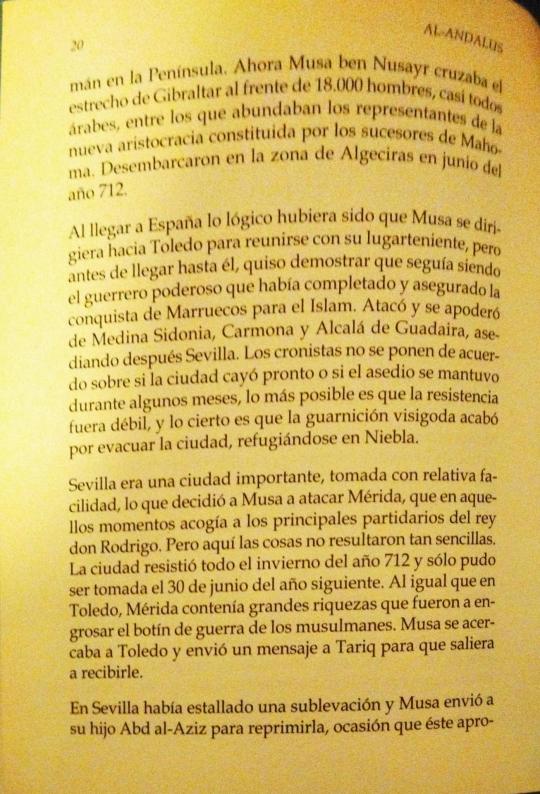
lim power on the Peninsula. Now Musa ben Nusayr crossed the Strait of Gibraltar at the head of 18,000 men, almost all Arabs, among whom were many representatives of the new aristocracy formed by the successors of Muhammad. They landed in the area of Algeciras in June of the year 712.
Upon arriving in Spania, it would have been logical for Musa to head towards Toledo to meet with his lieutenant, but before reaching him, he wanted to demonstrate that he was still the powerful warrior who had completed and ensured the conquest of Morocco for Islam. He attacked and took control of Medina Sidonia, Carmona and Alcalá de Guadaira, later besieging Seville. The chroniclers do not agree on whether the city fell soon or if the siege continued for a few months; it is most likely that the resistance was weak, and the truth is that the Visigoth garrison ended up evacuating the city, taking refuge in Niebla.
Seville was an important city, taken with relative ease, which decided Musa to attack Mérida, which at that time hosted the main supporters of King Don Rodrigo. But here things were not so simple. The city resisted throughout the winter of 712 and could only be taken on June 30 of the following year. As in Toledo, Mérida contained great riches that added to the war loot of the Muslims. Musa was approaching Toledo and sent a message to Tariq to come out to meet him.
An uprising had broken out in Seville and Musa sent his son Abd al-Aziz to suppress it, an opportunity that he took advantage
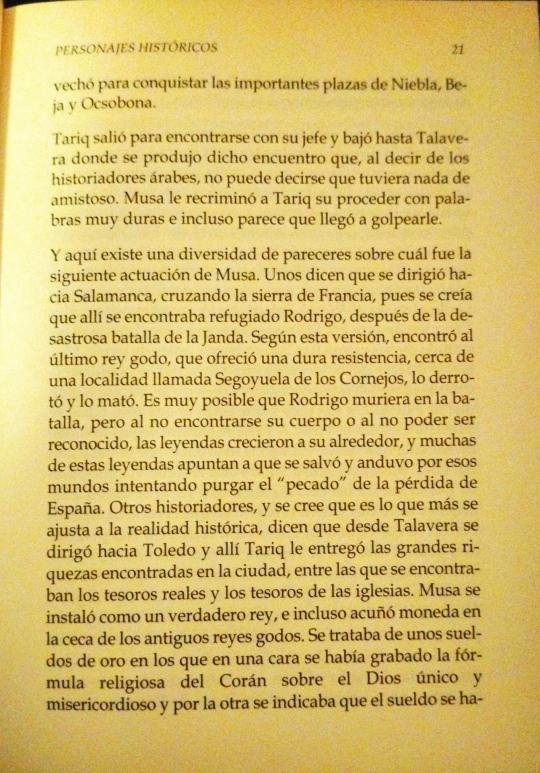
to conquer the important squares of Niebla, Beja and Ocsobona.
Tariq left to meet his boss and went down to Talavera where this meeting took place which, according to Arab historians, cannot be said to have had anything friendly. Musa reproached Tariq for his behavior with very harsh words and it seems that he even hit him.
And here there is a diversity of opinions about what Musa's next performance was. Some say that he headed towards Salamanca, crossing the Sierra de Francia, since it was believed that Rodrigo was taking refuge there after the disastrous battle of La Janda. According to this version, he found the last Gothic king, who offered tough resistance, near a town called Segoyuela de los Cornejos, defeated him and killed him. It is very possible that Rodrigo died in battle, but since his body was not found or could not be recognized, legends grew around him, and many of these legends suggest that he was saved and walked through those worlds trying to purge the “sin” of the loss of Spania. Other historians, and it is believed that this is what most closely corresponds to historical reality, say that from Talavera he headed towards Toledo and there Tariq gave him the great riches found in the city, among which were the treasures royals and the treasures of the churches. Musa installed himself as a true king, and even minted coins in the mint of the ancient Gothic kings. They were golden salaries on which the religious formula of the Koran about the only and merciful God had been engraved on one side and on the other it indicated that the salary had been
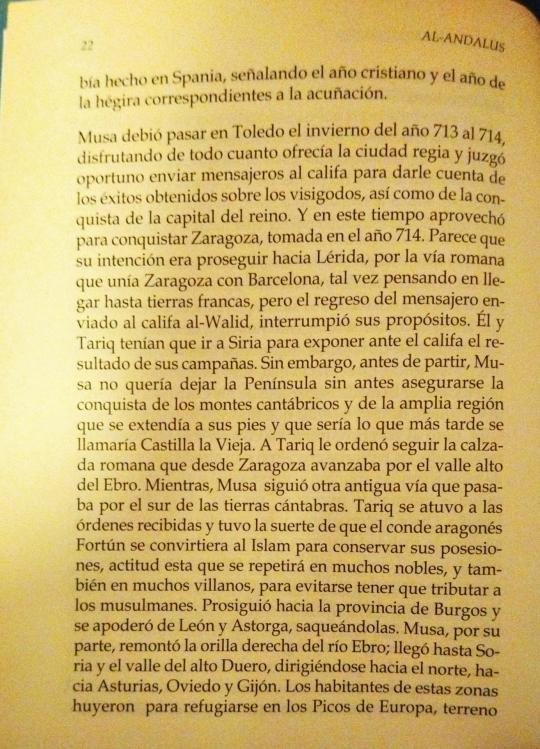
made in Spania, indicating the Christian year and the year of the hegira corresponding to the coinage.
Musa had to spend the winter from 713 to 714 in Toledo, enjoying everything that the royal city offered and considered it appropriate to send messengers to the caliph to inform him of the successes obtained against the Visigoths, as well as the conquest of the capital of the Kingdom. And at this time he took the opportunity to conquer Zaragoza, taken in the year 714. It seems that his intention was to continue towards Lleida, along the Roman road that linked Zaragoza with Barcelona, perhaps thinking of reaching Frankish lands, but when the messenger returned sent to the caliph al-Walid, interrupted his purposes. He and Tariq had to travel to Syria to present the results of their campaigns to the caliph. However, before leaving, Musa did not want to leave the Peninsula without first securing the conquest of the Cantabrian Mountains and the wide region that extended at its feet and which would later be called Old Castile. Tariq was ordered to follow the Roman road that advanced from Zaragoza through the upper Ebro valley. Meanwhile, Musa followed another ancient route that passed through the south of the Cantabrian lands. Tariq followed the orders he received and was lucky that the Aragonese count Fortún converted to Islam to preserve his possessions, an attitude that was repeated by many nobles, and also by many villains, so as not to have to pay taxes to Muslims. He continued towards the province of Burgos and took control of León and Astorga, plundering them. Musa, for his part, went up the right bank of the Ebro River; He reached Soria and the upper Duero valley, heading north towards Asturias, Oviedo and Gijón. The inhabitants of these areas fled to take refuge in the Picos de Europa mountain range, terrain
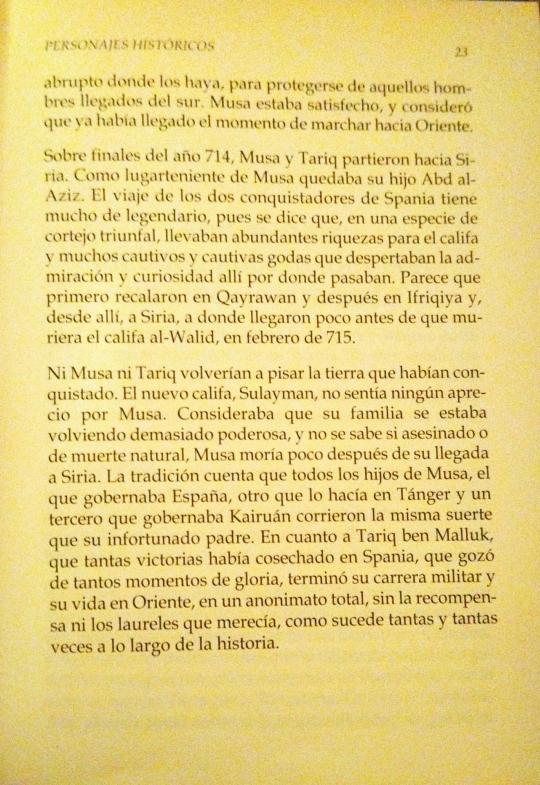
very abrupt, to protect themselves from those men arriving from the south. Musa was satisfied, and considered that the time had come to march towards the East.
Around the end of the year 714, Musa and Tariq left for Syria. Musa's lieutenant was his son Abd al-Aziz. The journey of the two conquerors of Spania is very legendary, since it is said that, in a kind of triumphal procession, they brought abundant riches for the caliph and many Gothic captives who aroused admiration and curiosity wherever they passed. It seems that they first landed in Qayrawan and then in Ifriqiya and, from there, to Syria, where they arrived shortly before the death of the Caliph al-Walid, in February 715.
Neither Musa nor Tariq would return to set foot on the land they had conquered. The new caliph, Sulayman, had no appreciation for Musa. He considered that his family was becoming too powerful, and it is not known whether murdered or a natural death, Musa died shortly after his arrival in Syria. Tradition says that all of Musa's sons, the one who ruled Spania, another who ruled in Tangier and a third who ruled Kairouan, suffered the same fate as their unfortunate father. As for Tarif ben Malluk, who had won so many victories in Spania, who enjoyed so many moments of glory, he ended his military career and his life in the East, in total anonymity, without the reward or laurels he deserved, as happens so many times throughout history.
#bookblr#historyblr#al andalus#al andalus. historical figures#al-andalus. personajes históricos#al andalus history#book scans#the conquest of al-andalus#fath al andalus#la conquista de al andalus#tariq ibn ziyad#musa ibn nusayr#tarif ibn malik#conde don julián#count don julián#julián de ceuta#spanish history
10 notes
·
View notes
Text
He derived that scant information by word of mouth, mainly from an envoy who had visited Pizarro's force for two days while it was en route inland from the coast.
"Guns, Germs and Steel: A Short History of Everybody for the Last 13,000 Years" - Jared Diamond
#book quote#guns germs and steel#jared diamond#nonfiction#envoy#atahuallpa#pizarro#Spanish conquest#inca empire#travel#colonization
2 notes
·
View notes
Text
"Reflecting further on the question — “¿Por qué arroz?” — he said that from his experience, he found that rice was consumed most in places where the church’s influence was strongest.
“What’s the connection between the church and rice?” I asked Lalo.
“It’s an influence from Europe,” he said easily, reminding me of how exotic rice could still seem in Mexico even 500 years after the Old World’s “discovery” of the Americas.
Catholicism — like rice and the knowledge of distillation, which made Lalo’s mezcal possible — had come with the Spanish conquest. That tale of Cortés, the rogue conquistador, who, having burned his boats, subdued the mighty lake-bound capital of the Aztecs, Tenochtitlan"- tracing Mexico’s Complicated Relationship With Rice, Aatish Taseer, New york times
#quotes#i knew that rice was post spanish conquest but....#huh i never thought of it so connected w catholics in that way#gonna be chewing on this one for a while pun intended
31 notes
·
View notes
Photo
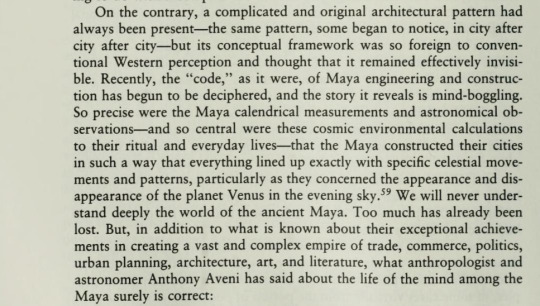
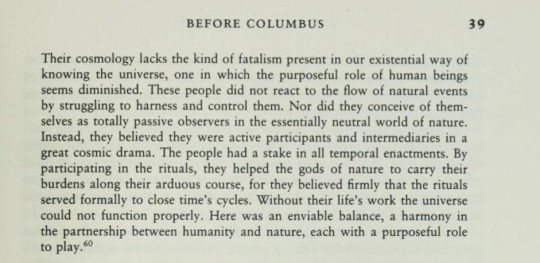
American Holocaust — David E. Stannard
#maya engineering#maya calendar#maya astronomy#astronomy#mayan#maya#venus#cosmology#harmony#humanity#nature#american holocaust#American Holocaust: The Conquest of the New World#holocaust#David E. Stannard#history#nonfiction#spanish#north america#south america#indigenous#atypicalreads#nsnv#colonialism#mesoamerica#pre-columbian#central america#literature#the americas#scans
4 notes
·
View notes